#biocomposites
Text
Natural Fiber Composites: Sustainable Materials For The Future

(Source – LinkedIn)
Natural fiber composites (NFCs) are emerging as a sustainable alternative to traditional composite materials. By combining natural fibers with a polymer matrix, NFCs offer a range of benefits including environmental friendliness, cost-effectiveness, and impressive mechanical properties. This article explores the various aspects of natural fiber composites, including their types, benefits, applications, challenges, and future trends.
Types of Natural Fibers Used in Composites
Natural fibers used in composites are derived from various sources, including plants, animals, and minerals. Each type of fiber brings unique properties to the composite material.
Plant Fibers: These are the most commonly used natural fibers in composites and include flax, jute, hemp, kenaf, sisal, and bamboo. Plant fibers are preferred for their high strength-to-weight ratio, biodegradability, and availability. Flax and jute, for instance, are popular in automotive and construction applications due to their mechanical properties and sustainability.
Animal Fibers: Wool and silk are the primary animal fibers used in composites. These fibers are known for their excellent elasticity, resilience, and biodegradability. While not as widely used as plant fibers, they are employed in specialized applications where their unique properties are advantageous.
Mineral Fibers: Basalt fiber is an example of a mineral fiber used in composites. It is derived from volcanic rock and offers high thermal stability, chemical resistance, and mechanical strength. Basalt fiber composites are used in high-performance applications such as aerospace and military equipment.
Benefits of Natural Fiber Composites
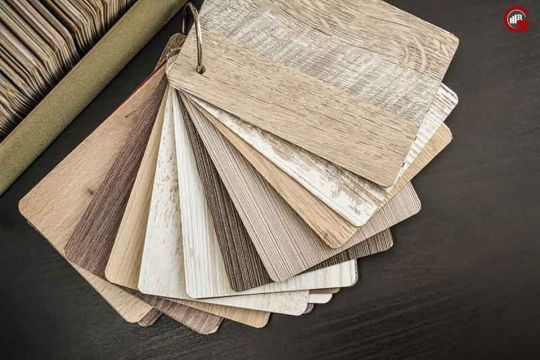
NFC offers several advantages over traditional materials, making them an attractive choice for various industries.
Environmental Sustainability: NFCs are more environmentally friendly than synthetic composites like fiberglass and carbon fiber. The production of natural fibers requires less energy and emits fewer greenhouse gases. Additionally, natural fibers are biodegradable, reducing the environmental impact at the end of the product lifecycle.
Lightweight: Natural fibers have a lower density compared to synthetic fibers, resulting in lighter composite materials. This is particularly beneficial in industries such as automotive and aerospace, where weight reduction leads to improved fuel efficiency and reduced emissions.
Cost-Effectiveness: Natural fibers are generally less expensive than synthetic fibers. They are sourced from renewable resources, which are often abundant and readily available. The lower material costs can lead to significant savings in manufacturing.
Mechanical Properties: Many natural fibers exhibit excellent mechanical properties, such as high tensile strength and stiffness. When combined with a suitable polymer matrix, NFCs can achieve comparable or even superior performance to traditional composites in certain applications.
Thermal and Acoustic Insulation: Natural fibers have good thermal and acoustic insulating properties. This makes NFCs suitable for use in building materials, automotive interiors, and other applications where insulation is important.
Applications of Natural Fiber Composites
NFCs are finding increasing use in a variety of industries, thanks to their unique properties and benefits.
Automotive Industry: NFCs are used in the production of interior and exterior automotive parts, such as door panels, dashboards, and bumpers. The lightweight nature of NFCs contributes to improved fuel efficiency and reduced emissions. Additionally, their biodegradability and sustainability align with the automotive industry’s push towards greener materials.
Construction and Building Materials: In the construction industry, NFCs are used in products like decking, roofing, insulation, and concrete reinforcement. Their durability, thermal insulation properties, and resistance to moisture and pests make them an excellent choice for building materials.

Sports and Leisure: Natural fiber composites are used in the manufacture of sporting goods such as bicycles, tennis rackets, and surfboards. Their lightweight and high strength make them ideal for performance equipment where both durability and weight are critical.
Consumer Goods: NFCs are also used in everyday consumer products like furniture, packaging, and electronics casings. The aesthetic appeal of natural fibers, combined with their environmental benefits, makes them attractive for sustainable product design.
Challenges in Natural Fiber Composites
Despite their numerous advantages, natural fiber composites face several challenges that need to be addressed to fully realize their potential.
Variability in Properties: Natural fibers can exhibit significant variability in their mechanical properties due to differences in growing conditions, harvesting methods, and processing techniques. This inconsistency can affect the performance and reliability of NFCs.
Moisture Absorption: Natural fibers tend to absorb moisture, which can lead to swelling, reduced mechanical properties, and degradation over time. Effective treatments and coatings are required to improve moisture resistance.
Compatibility with Polymer Matrices: Achieving good adhesion between natural fibers and polymer matrices can be challenging. Poor interfacial bonding can result in weak composites with suboptimal mechanical properties. Surface treatments and coupling agents are often used to enhance fiber-matrix compatibility.
Processing Techniques: The processing of natural fiber composites can be more complex than that of synthetic composites. Factors such as fiber orientation, length, and dispersion need to be carefully controlled to achieve uniform and high-quality composites.
Long-Term Durability: Ensuring the long-term durability and stability of NFCs under various environmental conditions is essential for their widespread adoption. Research and development are ongoing to improve the performance and lifespan of these materials.
Future Trends in Natural Fiber Composites
The future of natural fiber composites looks promising, with ongoing research and innovation driving the development of new materials and applications.
Advanced Treatments and Modifications: Research is focused on developing advanced treatments and surface modifications to enhance the properties of natural fibers. This includes improving moisture resistance, mechanical strength, and compatibility with polymer matrices.
Hybrid Composites: Combining natural fibers with synthetic fibers or other natural fibers can create hybrid composites with tailored properties. This approach allows for the optimization of mechanical performance, cost, and sustainability.
Bio-Based Matrices: The development of bio-based polymer matrices that are derived from renewable resources is gaining traction. These matrices, when combined with natural fibers, result in fully sustainable composites with minimal environmental impact.

New Applications: As the properties and performance of NFCs improve, new applications are emerging. These include medical devices, wearable technology, and renewable energy components such as wind turbine blades.
In conclusion, natural fiber composites offer a sustainable and versatile alternative to traditional composite materials. Their environmental benefits, combined with their mechanical properties and cost-effectiveness, make them an attractive choice for a wide range of applications. While challenges remain, ongoing research and innovation are paving the way for the broader adoption of NFCs in various industries. By addressing these challenges and leveraging future trends, natural fiber composites have the potential to play a significant role in the development of sustainable materials for the future.
0 notes
Text

🔜 3 Days Left‼️
Hurry Only Few Seats Left !!
🔰 VIRTUAL ONLINE FELLOWSHIP IN OSTEOARTICULAR INFECTIONS - BATCH 3
🙋🏻♂️Learn the best practices for the prevention and management of Osteoarticular Infections and tuberculosis
🔆 3 Months Online Focused Certificate Course beginning in February 2024.
🔗 LIMITED SEATS Register Now: https://tinyurl.com/OrthoTV-Fellowship
🔅 Learn:
Principles and Surgical Tips, Tricks, & Techniques to prevent & manage osteoarticular infections.
🔅 Who Can Apply:
All Orthopaedic Surgeons and Ortho PGs.
👨🏫 Mentors:
Dr. Vikas Agashe
Dr. Anand Thakur
Dr. Aditya Menon
👩🏫 Faculty:
Dr. Bimal Mody, Dr. Samir Dalvie, Dr. Ayesha Sunavala, Dr. Mandar Agashe, Dr. Aditya Menon, and others.
🔅 Syllabus Highlights:
Comprehensive coverage of OA infections, open fractures, biofilm, mycobacterial infections, paediatric osteomyelitis, and more.
🔅 Hybrid Physical Meeting Topics:
Role of microbiological diagnosis in FRI, imaging in infection, ABC of antibiotics, and the role of plastic surgery.
🔅 Course Highlights:
10 Weekly Live online sessions, a physical/hybrid meeting in Mumbai, direct master interaction, WhatsApp group discussions, and case studies.
💵 Course Fees:
INR 30000 (+18% GST) for Indian Nationals and USD 500 for Foreign Nationals.
🏅 Organised by Orthopaedic Research Group & OrthoTV Global Academy.
🔆Supported by: Biocomposites
#OnlineFellowship#OsteoarticularInfections#OrthoTV#Orthopedics#MedicalEducation#OrthopedicSurgeons#PGOrtho#VikasAgashe#AnandThakur#AdityaMenon#BimalMody#SamirDalvie#AyeshaSunavala#MandarAgashe#OrthopaedicResearchGroup#HybridMeeting#Biofilm#OpenFractures#OrthoTVGlobalAcademy#Biocomposites#OrthoPGs
0 notes
Text
Global Biocomposites Market In 2022 : Increasing Demand In Construction, Chemical, Automotive Sectors.

The Global Biocomposites Market is projected to reach USD 52.3 billion by 2027, witnessing a CAGR of 16.2% during the forecast period 2021-2027.
To assist companies in developing their business plans, the research examines the major factors influencing the growth of the Global Biocomposites Market, also including Drivers, Constraints, Governmental Policies, Opportunities, Challenges, and a Constructive Approach, and Market Economic Expansion Strategies.
Get a free sample copy of this market research: https://www.vynzresearch.com/chemicals-materials/biocomposites-market/request-sample
#Biocomposites#Biocomposites Market#Biocomposites Market SIze#Biocomposites Market Share#Biocomposites Market ANalysis
0 notes
Text
Biocomposites Market To Generate USD 103.6 Billion by 2030
Biodegradable polymer serves as the matrix material in biocomposites, which typically also contain bio-fibers as reinforcing elements. Moreover, biocomposites have the following characteristics: low cost, low density, high toughness, acceptable specific strength properties, good thermal properties, ease of separation, improved energy recovery, and biodegradability.
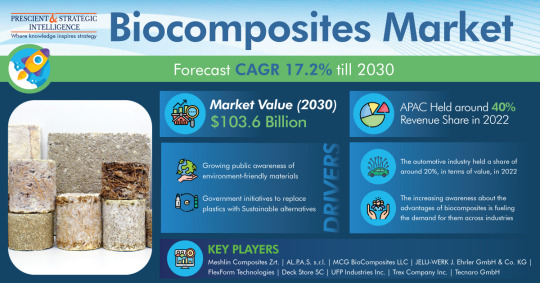
As per a report by P&S Intelligence, the biocomposites market is on track to reaching USD 103.6 billion by 2030. This is because more people are becoming aware of eco-friendly materials and because the government is taking steps to replace plastics with them. A further factor driving material demand is the car industry's growing desire to lighten and increase passenger safety.
NFCs are frequently employed in car interior components such as windows, driver cabins, doors, and dashboards. On the other hand, WPCs are mostly used in the construction of seat bases, back shelf trims for the spare tire and trunk, headliners, and inside door trims.
As a result, practically all European and North American OEMs have included them in their ambitious goals to reduce weight in order to comply with stringent environmental laws. This is due to the rising use of these materials in vehicles.
Due to its fast industrialization, APAC also represented the greatest value share in the worldwide market. Essentially, the rising requirement for such materials from the automobile and consumer goods sectors is what is driving market expansion in the region.
The market is also expected to be driven by the growing need in the building and construction sector for materials that are biodegradable, non-toxic, moisture- and thermally-resistant.
Furthermore, APAC is developing into a hub for producers of biocomposite materials, and it is anticipated that it will record a strong need for such materials in the years to come. Additionally, these materials are widely used in cooling tower units to prevent moisture-related corrosion.
For instance, as part of the Saudi Vision 2030 development plan, the Kingdom of Saudi Arabia is undertaking a number of large-scale infrastructure projects, such as the Red Sea Project, Qiddiya Entertainment City, King Abdullah Financial District, and Neom City, all of which are expected to support business and corporate expansion.
#Biocomposites Market#Biocomposites Market Size#Biocomposites Market Share#Biocomposites Market Trends#Biocomposites Market Outlook
0 notes
Text
First-ever 3D-printed biocomposite pipes play in Helsinki Music Centre’s organ
The new organ of the Helsinki Music Centre played in a celebratory concert on January 1, 2024. The striking facade pipes of the Rieger organ are the first of their kind, crafted from Finnish, wood-based UPM Formi 3D biocomposite. The organ features 3D-printed sounding pipes and wind lines totalling 260 meters. With 124 sound registers divided among several different sets of pipes, it is the…
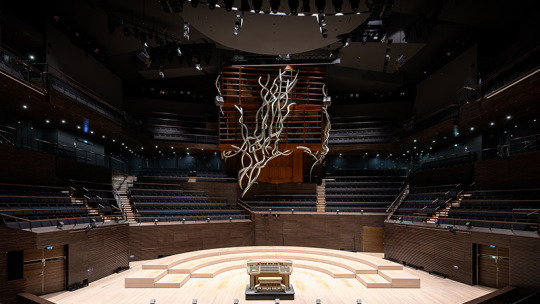
View On WordPress
0 notes
Text
Soundpeats Clear Wireless Earbuds
The tech on offer here vastly outweighs the low price tag and demonstrates a commitment to consumers over profit.
SoundPEATS Clear wireless earbuds stand out, not just for their impressive technological features but also for their distinctive transparent futuristic design. These earbuds promise a harmonious blend of aesthetics and functionality, making them a compelling choice for enthusiasts seeking both style and substance. But what do you get for the modest price?
Product supplied for review…

View On WordPress
#12mm dynamic driver earbuds#40-hour playback time earbuds#Advanced Bluetooth chip earbuds#All-day comfort earbuds#Best wireless earbuds 2023#Biocomposite diaphragm dynamic driver#blog#Bluetooth 5.3 technology#crazydiscostu#Dual microphone noise reduction#ENC for clear calls earphones#Extended battery life earphones#Fast one-step pairing earphones#Game Mode and App Control earphones#geek#Immersive sound wireless earbuds#IPX4 waterproof rating earbuds#Nerd#review#reviews#soundpeats#SoundPEATS audio technology#SoundPEATS Clear earbuds#SoundPEATS Clear review#SoundPEATS wireless headphones#Stylish and functional earphones#Tech#Tech specs SoundPEATS Clear#Touch control in-ear headphones#Transparent black earbuds
0 notes
Text
Investing in Biocomposites: A Promising Market for Sustainable Investors
Investing in biocomposites market presents a promising opportunity for sustainable investors looking to make a positive environmental impact while also seeking financial returns. Biocomposites, which are sustainable materials made from renewable resources, have gained significant attention in recent years as the demand for eco-friendly alternatives to traditional materials continues to rise.
There are several reasons why investing in biocomposites is an attractive option for sustainable investors. Firstly, biocomposites align with the principles of sustainability and environmental responsibility. By investing in this market, investors can support the development and adoption of materials that have a lower carbon footprint and reduce reliance on non-renewable resources. This contributes to mitigating climate change and promoting a more sustainable future.
Secondly, the market for biocomposites is experiencing rapid growth and expansion. According to reports, the global biocomposites market is projected to reach a value of billions of dollars in the coming years. This growth is driven by increasing consumer demand for sustainable products across various industries, including automotive, construction, packaging, and consumer goods. By investing in biocomposites, investors can tap into this growing market and potentially benefit from its financial upside.
Furthermore, governments and regulatory bodies are actively supporting the development and adoption of biocomposites through policies and incentives. This creates a favorable investment landscape, as government support can drive market demand and provide a stable environment for companies operating in the biocomposites sector.
When considering investments in biocomposites, investors should conduct thorough due diligence. It is essential to evaluate the technologies, manufacturing processes, and market potential of the companies involved. Assessing factors such as scalability, competitive advantage, and partnerships will help investors make informed decisions.
Investing in biocomposites can be done through various avenues. Sustainable investors can consider investing directly in companies that specialize in biocomposite production or those that incorporate biocomposites into their products. Additionally, there are investment funds and exchange-traded funds (ETFs) that focus on sustainable materials or environmental technologies, which may include biocomposites as part of their portfolio.
In conclusion, investing in biocomposites offers a promising opportunity for sustainable investors. It allows investors to support the development of eco-friendly materials while potentially benefiting from the growth of a market driven by increasing demand for sustainable products. By carefully evaluating investment opportunities and considering long-term sustainability goals, investors can align their financial objectives with their commitment to environmental stewardship.
#biocomposites market#biocomposites market size#biocomposites market trends#biocomposites market analysis
0 notes
Text
Biocomposites Market Assessment and Key Insights Analyzed from 2022 - 2032
Over the forecast period, the global biocomposites market is predicted to increase at an exponential rate of 16%. Valued at US$ 25 Bn in 2021, the biocomposites market is anticipated to reach US$ 128 Bn by 2032.
The increased research and development efforts for composite materials and biocomposite uses and benefits such as recyclability, lightweight, and cost-effectiveness are driving this trend. In addition, due to the harmful nature of synthetic materials, recycling challenges, and toxic residues, the biocomposites market size will continue to expand throughout the predicted timetable.
As per the biocomposites market report, Germany, the United States, and Japan are among the developed countries working on boosting the usage of ecologically friendly items rather than petroleum-based products.
Get a Sample Copy of this Report @
https://www.futuremarketinsights.com/reports/sample/rep-gb-14293
The European Union (EU) has favored such items over the United States and Japanese governments. It requires the use of bio-based materials, encourages the recyclability of vehicle components, and holds automakers accountable for disposal at the end of the vehicle’s service life. These laws are likely to boost demand for biocomposites in various end-use industries, including transportation, construction, and electrical and electronics.
The power necessary to make biocomposites is far lower than that critical to making glass fiber composites or carbon fiber composites. On the other hand, Biocomposites are more expensive than glass fiber composites. However, price reductions are prospects due to economies of scale and common biocomposites applications.
COVID-19 has had a detrimental impact on sales of biocomposites due to a drop in demand from numerous end-use sectors. Being one of the largest users of biocomposites, building and construction have seen the worst and most immediate effects of the epidemic. The building industry has been hit the worst. This has had a negative biocomposites market outlook.
Advancing at a CAGR of 16%, the biocomposites market size is expected to reach US$ 51 Bn by 2026.
Key Takeaways
The hybrid composites product section captured the largest market size in the global biocomposites market, owing to increased biocomposites applications around the world. Its substantial market share is credited with the optimum fiber adhesion that leads to decreased moisture content, high strength, and structural capacity.
As per the biocomposites adoption trends, they are predicted to be the dominant market in the Asia Pacific. Over the projected period, it is also anticipated to be the fastest regional market.
The requirement for synthetic polymer biocomposites had decreased in 2020 because of the COVID-19 pandemic. As global end-use industries found a stable footing by the fourth quarter of 2020, demand for biocomposites also showed signs of recovery.
The market for biocomposites is dominated by the building and construction industry.
Wood fiber composites have the biggest market share in volume in the global biocomposites industry.
“The need for biocomposites is increasing in the building and construction, transportation, consumer goods, and other end-use industries. However, as a result of COVID-19, sales in various industries have decreased, reducing demand for biocomposites.”—opines an FMI analyst.
Get more Information on this Report @ https://www.futuremarketinsights.com/reports/biocomposites-market
Competitive Landscape
To gain a foothold in the biocomposites market opportunities, the key companies in the industry are pursuing a variety of inorganic and organic techniques.
Biocomposites, an international medical device company that produces and manufactures leading products for bone and soft tissue infection management, announced today that its STMULAN products are, vancomycin, gentamycin, and tobramycin, have received new Canadian approval for the mixing of antibiotics with them.
0 notes
Text
Real Innovations: 3 biobased building materials of the future

Hempcrete is insulating and breathable. An ideal building material.
Which innovations are really going to make a difference and should we keep an eye on them? We ask experts in their field. This time: architect Daan Bruggink on biobased building materials of the future.
Anyone who says biobased construction refers to wood construction in the first place. [1] The sector is developing rapidly and is only expected to grow in size in the coming decades. But of course there are many more promising biobased materials in the proverbial starting blocks. Whether they all have a future is another matter, says Bruggink. “Mycelium, for example, is a promising material that fits perfectly into the story of biobased construction. But it has not yet been tried out, tested, certified, you name it. That is the essence for many biobased materials, when going through that entire process. It costs a lot of time and money and not every start-up has the means to perpetrate this.”[2]
Which biobased materials (apart from wood) are ready for rapid upscaling and the future? Bruggink selected three:
1. Agricultural (residual) material
Bruggink: “The biggest development I see at the moment is the use of agricultural crops. Think, for example, of wheat stalks, hemp and bulrush. They have very strong fibres; hemp, for example, was also used to make rope and sails. Agricultural crops have enormous potential as insulation material and can also be scaled up fairly quickly, I expect. It is produced, certified, put it in a wooden sleeve and you're done. Very short-sighted, of course, but that's basically what it ends up to. Which specific agricultural crops will win the race is difficult to predict. In an ideal world, per project one considcers the crops that are available and suitable.”
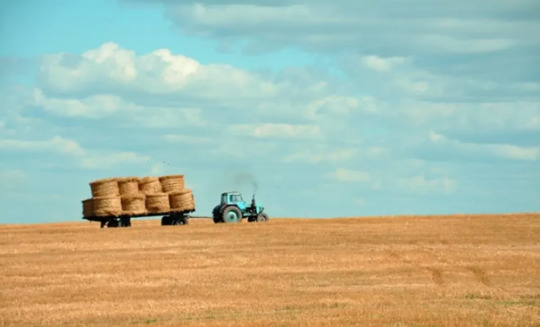
Straw is a commonly used biobased product for construction (especially roofs for new construction). It is not only a residual product of livestock farming, but can also be grown, harvested and replanted specifically for the construction industry.
2. Hempcrete
“Some agricultural crops can also be combined very well with other materials. Hemp is a good example of this. When it is combined with lime, a biobased material is obtained that can be used for insulation, but one can also build with it. Think of it as a kind of biobased sand-lime brick. To actually build, wooden posts are currently still needed in between, to support the construction. But I expect that there is a lot of future in hemplime.”
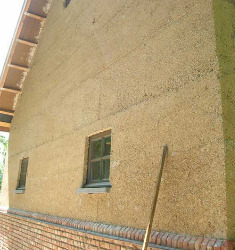
Hempcrete insulation
3. Biocomposite
“A third important trend is the emergence of biocomposite[3]. A company like Nabasco[4] is already showing the possibilities. They have facade panels in their product portfolio, made from reed clippings. But other natural fibres, such as flax and hemp, are also possible.

Circular Matters launches new biocomposite sheet material
The question is: will it be possible to make a biocomposite that is 100 percent biobased? The products currently on the market are around 80 percent. But I expect it to be a matter of time before there are biocomposite panels on the market that are completely biobased.”[5]
Source
Hidde Middelweerd: Echte Innovaties: 3 biobased bouwmaterialen van de toekomst, in: Change Inc, 20-12-2022, https://www.change.inc/infra/echte-innovaties-3-biobased-bouwmaterialen-van-de-toekomst-39348
[1] Read also: https://at.tumblr.com/earaercircular/the-climate-helps-building/5cri1jglt8q4 & https://at.tumblr.com/earaercircular/new-technology-from-norway-ensures-that-we-dont/6tzs3iij57jr
[2] Read also: https://at.tumblr.com/earaercircular/mushrooms-to-insulate-houses/xwe12tc02hri
[3] A biocomposite is a composite material formed by a matrix (resin) and a reinforcement of natural fibres. Environmental concern and cost of synthetic fibres have led the foundation of using natural fibre as reinforcement in polymeric composites.
[4] Nabasco products realizes innovative and sustainable facades with its partner NPSP. Our facade systems are composed and produced customer-specifically. With Nabasco® Sign they introduce the most environmentally friendly and at the same time high-quality traffic sign that shows that top quality and sustainability go hand in hand. https://nabasco.nl/collections/all
[5] Read also: https://at.tumblr.com/earaercircular/new-technology-from-norway-ensures-that-we-dont/6tzs3iij57jr
0 notes
Text
The global biocomposites market size was USD 24.4 billion in 2021 and is expected to reach USD 51.2 billion by 2026, projecting a CAGR of 16.0% between 2021 and 2026. Biocomposites are increasingly used in the transportation end-use industry as they decrease weight and increase fuel efficiency. Automotive manufacturers are increasingly using biocomposites in various automobile models. The regulatory legislation imposed by the EU and other countries, such as the US, India, and Japan; are expected to increase the use of biocomposites, primarily in the automotive end-use industry. The EU legislation sets mandatory emission reduction targets for new cars to improve fuel economy and reduce the CO2 emissions.
The US has also imposed stricter Corporate Average Fuel Economy (CAFE) and tailpipe emission standards for the automobile sector. The proposed mandate raised CAFÉ standards to 39 mpg for passenger cars by 2016 and 54.5 mpg by 2025. China and Japan have also announced vehicle fuel economy regulations. Brazil, India, Mexico, and South Africa are expected to initiate similar measures in the near future. The above-mentioned factors and increased incorporation of biocomposites are expected to increase their demand mainly in the automobile sector.
The automotive industry focuses on stringent regulations, such as the Corporate Average Fuel Efficiency (CAFE) standards and the European Emission Standards (EES) by the US and European governments, respectively, for vehicle manufacturers. According to the United States Environmental Protection Agency (EPA), the transportation industry in the US is one of the largest contributors to greenhouse gas emissions. The US government has, thus, made it a critical concern for automakers to follow the average miles per gallon standard for their vehicles. A similar situation is prevalent in other regions across the globe. In order to reduce carbon dioxide (CO2) emissions, automakers focus significantly on producing lightweight vehicles to comply with government regulations and enhance fuel efficiency.
#Biocomposites Market#bio composite#bio composites#biocomposite products#biocomposite plastic#biocomposites reinforced with natural fibers#bio composite material#biofibres and biocomposites#Biocomposites Industry#COVID 19 impact on Biocomposites Market#Asia Pacific Biocomposites Market#wood fiber composites#Global Biocomposites Market#Biocomposites Market share#Biocomposites Market Size#Biocomposites Market Demand#Biocomposites Market Growth#Biocomposites Market Opportunity#Sales of Biocomposites#Demand of Biocomposites#Europe Biocomposites Market#North America Biocomposites Market
0 notes
Text

🔰 VIRTUAL ONLINE FELLOWSHIP IN OSTEOARTICULAR INFECTIONS - BATCH 3
🙋🏻♂️Learn the best practices for the prevention and management of Osteoarticular Infections and tuberculosis
🔆 3 Months Online Focused Certificate Course beginning in February 2024.
🔗 LIMITED SEATS Register Now: https://tinyurl.com/OrthoTV-Fellowship
🔅 Learn:
Principles and Surgical Tips, Tricks, & Techniques to prevent & manage osteoarticular infections.
🔅 Who Can Apply:
All Orthopaedic Surgeons and Ortho PGs.
👨🏫 Mentors:
Dr. Vikas Agashe
Dr. Anand Thakur
Dr. Aditya Menon
👩🏫 Faculty:
Dr. Bimal Mody, Dr. Samir Dalvie, Dr. Ayesha Sunavala, Dr. Mandar Agashe, Dr. Aditya Menon, and others.
🔅 Syllabus Highlights:
Comprehensive coverage of OA infections, open fractures, biofilm, mycobacterial infections, paediatric osteomyelitis, and more.
🔅 Hybrid Physical Meeting Topics:
Role of microbiological diagnosis in FRI, imaging in infection, ABC of antibiotics, and the role of plastic surgery.
🔅 Course Highlights:
10 Weekly Live online sessions, a physical/hybrid meeting in Mumbai, direct master interaction, WhatsApp group discussions, and case studies.
💵 Course Fees:
INR 30000 (+18% GST) for Indian Nationals and USD 500 for Foreign Nationals.
🏅 Organised by Orthopaedic Research Group & OrthoTV Global Academy.
🔆Supported by: Biocomposites
#OrthoTV#OsteoarticularInfections#Fellowship#Orthopedics#MedicalEducation#OnlineCourse#SurgicalTechniques#InfectionPrevention#OrthoPG#MedicalTraining#HybridMeeting#OrthopedicResearch#MedicalAcademy#OrthopedicSurgeons#MedicalFaculty#OrthopedicEducation#InfectiousDiseases#Biocomposites#OrthopedicCommunity#CaseStudies#OrthoResearchGroup#MedicalMentors#SurgicalTips#OrthopedicPractice#HealthcareLearning#OrthopedicExperts
1 note
·
View note
Text
Global Biocomposites Regional, Global Analysis and Forecast, 2022–2028.

A composite material is a material in which one or more continuous phases are combined into a discontinuous phase. The continuous phase is called matrix and the discontinuous phase is called reinforcement or filler. Biocomposites are materials made from natural and renewable resources. Recently, due to the environmental crisis and sustainability issues, the interest in using natural fibers as reinforcement materials has increased significantly.
Read more: https://introspectivemarketresearch.com/reports/biocomposites-market/
#Global Biocomposites Market#Global Biocomposites Market share#Global Biocomposites Market size#Global Biocomposites Market industry#Global Biocomposites Market growth
0 notes
Text
Biocomposites Market Trends, Growth, Size, Segmentation, Future Demands, Latest Innovation, Regional Forecast to 2028
Biocomposites Market Trends, Growth, Size, Segmentation, Future Demands, Latest Innovation, Regional Forecast to 2028
Growing Demand for Biocomposites from Automotive Industry to Escalate Biocomposites Market Growth During 2022–2028
According to our latest market study on “Biocomposites Market Forecast to 2028 – COVID-19 Impact and Global Analysis – by Fiber (Wood Fiber Composite and Non-Wood Fiber Composite), Product (Hybrid Composite and Green Composite), and End-Use Industry (Building & Construction,…
View On WordPress
#Biocomposites Market#Biocomposites Market Growth#Biocomposites Market Share#Biocomposites Market Size
0 notes